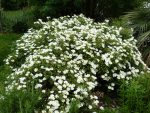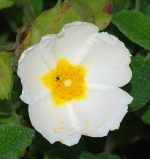A lso known as salvia cistus and Gallipoli rose, this bushy evergreen shrub is native to the Mediterranean region, including southern Europe, parts of Western Asia and North Africa. It is a member of the Cistaceae family, a small group of shrubs and semi shrubs that do well in dry, sunny locations with poor soil. Plants grow 12-24″ tall and have oval, gray- green leaves that are .4-1.5″ long, wrinkled and covered with woolly matted hairs. The flowers appear from spring into summer, are 1.5-2.4″ wide, and have orange yellow stamens in the center surrounded by 5 white petals with a yellow spot at the base. The flowers are very attractive to bees. The whole plant is covered with a sticky fragrant resin. Photo Credit ghislain Wikipedia
lso known as salvia cistus and Gallipoli rose, this bushy evergreen shrub is native to the Mediterranean region, including southern Europe, parts of Western Asia and North Africa. It is a member of the Cistaceae family, a small group of shrubs and semi shrubs that do well in dry, sunny locations with poor soil. Plants grow 12-24″ tall and have oval, gray- green leaves that are .4-1.5″ long, wrinkled and covered with woolly matted hairs. The flowers appear from spring into summer, are 1.5-2.4″ wide, and have orange yellow stamens in the center surrounded by 5 white petals with a yellow spot at the base. The flowers are very attractive to bees. The whole plant is covered with a sticky fragrant resin. Photo Credit ghislain Wikipedia
 The Hebrew word lot (לט) is usually translated as myrrh but myrrh is not indigenous to Gilead or Palestine as the context of the passages suggest. Better translations would be resinous gum or ladanum, a substance produced by species of rock rose. Ladanum is a dark-brown to black, sticky exude collected from the stems and leaves of the plants. It has a bitter taste and a fragrant odor and was historically used in herbal medicine and incense but is now used to make perfume and vermouth. Both Cistus salviafolius and C. creticus could provide ladanum. Photo Credit Wikipedia
The Hebrew word lot (לט) is usually translated as myrrh but myrrh is not indigenous to Gilead or Palestine as the context of the passages suggest. Better translations would be resinous gum or ladanum, a substance produced by species of rock rose. Ladanum is a dark-brown to black, sticky exude collected from the stems and leaves of the plants. It has a bitter taste and a fragrant odor and was historically used in herbal medicine and incense but is now used to make perfume and vermouth. Both Cistus salviafolius and C. creticus could provide ladanum. Photo Credit Wikipedia
Genesis 37:25 (NIV) After throwing Joseph into a pit, his brothers gather to eat and discuss their plans.
“As they [Joseph’s brothers] sat down to eat their meal, they looked up and saw a caravan of Ishmaelites coming from Gilead. Their camels were loaded with spices, balm and myrrh, and they were on their way to take them down to Egypt.”
Genesis 43:11 (NIV) Jacob told his sons to take some valued items to Egypt to trade for grain.
“Then their father Israel said to them, “If it must be, then do this: Put some of the best products of the land in your bags and take them down to the man as a gift—a little balm and a little honey, some spices and myrrh, some pistachio nuts and almonds.”
Salvia-leafed rockrose likes full sun and lean, loose, coarse, very well-drained soil in USDA Hardiness Zones 8-10 and tolerates drought and maritime exposure. It needs cool roots so should be mulched in summer. Tip pruning promotes bushiness but hard pruning is not tolerated. Plants are generally healthy and are notably resistant to honey fungus. Propagation is by seed and softwood cuttings. Salvia-leafed rockrose is a good choice for a ground cover, and seaside, rock, gravel, wildlife, and Mediterranean gardens.
The genus name Cistus is from the ancient Greek word σθος (kistκίhos) meaning basket. The specific epithet, salviifolius, come from the Latin words salvia the botanical name for sage, and folius meaning leaf, referring to the similar appearance of the leaves to those of sage.